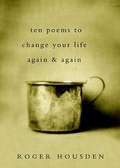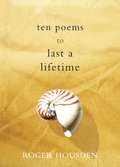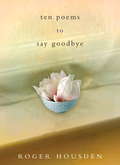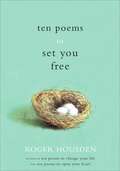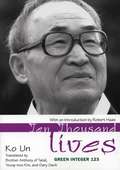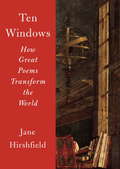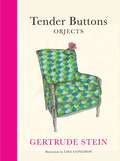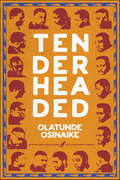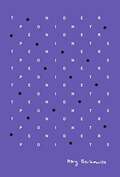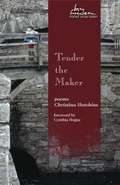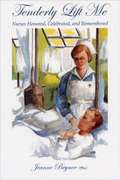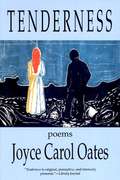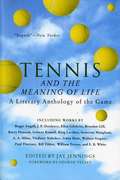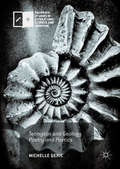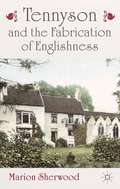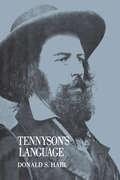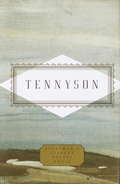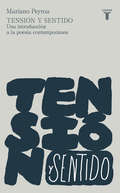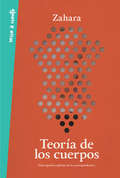- Table View
- List View
Ten Poems to Change Your Life Again and Again
by Roger HousdenEvery great poem invites us to step beyond what we know, what we think we can dream or dare. Great poetry is a catalyst for change: a change of mind, a change of heart, a change of life- and yes, over and over, again and again, with each new reading, and each new phase of our journey. That’s why poetry is dangerous. It gives voice to our unspoken dreams; it is a mirror to our own deepest joys, desires, and sorrows. It can tip us over into a new life, into a new way of seeing and being, that a moment ago we might even have had no words for. In this new volume of his Ten Poems series, Roger Housden takes ten great poems and in personal, intimate essays shows how they led him, and can also lead us, into a more deeply lived and examined life. Housden says, “Every one of the poems in this book has struck me a blow, a direct hit, each of them, into the heart of hearts. Every one of them, in its own way, has opened a door for me to go deeper into my own experience, my own longings, my own sorrows and joys, and into the silence that surrounds all of this, all of us, always. ”
Ten Poems to Last a Lifetime
by Roger HousdenThe fourth volume in the popular series that began with Ten Poems to Change Your Life, Ten Poems to Last a Lifetime focuses on what it means to be truly human. In it, Roger Housden offers us poems on life and death, happiness, seeing ourselves in relation to the world, and, of course, the ineffable—the things that really matter when the chips are down. He describes these passionate poems as “bread for the soul and fire for the spirit.” The poets Housden has chosen are Billy Collins, Hayden Carruth, Dorianne Laux, James Wright, Naomi Shihab Nye, and Mary Oliver from the United States, D. H. Lawrence and John Keats from England, Rainer Maria Rilke from Germany, Fleur Adcock from New Zealand, and Seng-Ts’an from sixth-century China. And yes, that adds up to eleven, not ten. Housden decided to include a bonus poem for his faithful readers in this, the final volume of the series. As before, Housden’s luminous essays provide an elegant and easy passage into the sometimes daunting world of poetry, enabling readers to feel that in him they have found a trusted guide and mentor.From the Hardcover edition.
Ten Poems to Say Goodbye
by Roger HousdenIn Ten Poems to Say Goodbye, the newest addition to the celebrated Ten Poems series, Roger Housden continues to highlight the magic of poetry, this time as it relates to personal loss. But while the selected poems in this volume may focus upon loss and grief, they also reflect solace, respite, and joy. A goodbye is an opportunity for kindness, for forgiveness, for intimacy, and ultimately for love and a deepening acceptance of life as it is rather than what it was. Goodbyes can be poignant, sorrowful, sometimes a relief, and--now and then--even an occasion for joy. They are always transitions that, when embraced, can be the door to a new life both for ourselves and for others. In this inspiring and consoling volume, Housden encourages readers to embrace poetry as a way of enabling us to better see and appreciate the beauty of the world around and within us.
Ten Poems to Set You Free
by Roger HousdenTen Poems to Set You Free inspires you to claim the life that is truly yours. In today’s world it is deceptively easy to lose sight of our direction and the things that matter and give us joy. How quickly the days can slip by, the years all gone, and we, at the end of our lives, mourning the life we dreamed of but never lived. These ten poems, and Roger Housden’s reflections on them, urge us to stand once and for all, and now, in the heart of our own life.This volume brings together the voices of Thomas Merton, David Whyte, the Basque poet Miguel de Unamuno, Anna Swir from Poland, Stanley Kunitz, the Greek poet C. P. Cavafy, and Jane Hirshfield, as well as three of Housden’s favorites, Rumi, Mary Oliver, and Naomi Shihab Nye. His luminous essays on the poems show us how to integrate the poets’ truth into our own lives.Roger Housden’s love of poetry and life leaps from every page—so much so that his readers feel they have found a guide and mentor through the extraordinary Ten Poems series. He has opened the eyes and hearts of many, not just to the power of poetry, but to the truth and beauty of the life of the soul. What more can one ask?
Ten Sly Piranhas: A Counting Story In Reverse (a Tale Of Wickedness - And Worse!)
by William WiseA school of ten sly piranhas gradually dwindles as they waylay and eat each other.
Ten Thousand Lives
by Ko UnKo Un grew up in a formerly Japanese-controlled territory that was very much the center of the Korean War. Ten Thousand Lives is his major, ongoing work, which began during his imprisonment, when he determined to describe every person he had ever met. The selection in this volume—from the first 10 volumes—represents one of the major classics of twentieth-century Korean literature, published for the first time in English.
Ten Windows
by Jane HirshfieldA dazzling collection of essays on how the best poems work, from the master poet and essayist "Poetry," Jane Hirshfield has said, "is language that foments revolutions of being." In ten eloquent and highly original explorations, she unfolds and explores some of the ways this is done--by the inclusion of hiddenness, paradox, and surprise; by a perennial awareness of the place of uncertainty in our lives; by language's own acts of discovery; by the powers of image, statement, music, and feeling to enlarge in every direction. The lucid understandings presented here are gripping and transformative in themselves. Investigating the power of poetry to move and change us becomes in these pages an equal investigation into the inhabitance and navigation of our human lives. Closely reading poems by Dickinson, Bashō, Szymborska, Cavafy, Heaney, Bishop, and Komunyakaa, among many others, Hirshfield reveals how poetry's world-making takes place: word by charged word. By expanding what is imaginable and sayable, Hirshfield proposes, poems expand what is possible. Ten Windows restores us at every turn to a more precise, sensuous, and deepened experience of our shared humanity and of the seemingly limitless means by which that knowledge is both summoned and forged.From the Hardcover edition.
Ten Windows: How Great Poems Transform the World
by Jane HirshfieldA dazzling collection of essays on how the best poems work, from the master poet and essayist “Poetry,” Jane Hirshfield has said, “is language that foments revolutions of being.” In ten eloquent and highly original explorations, she unfolds and explores some of the ways this is done—by the inclusion of hiddenness, paradox, and surprise; by a perennial awareness of the place of uncertainty in our lives; by language’s own acts of discovery; by the powers of image, statement, music, and feeling to enlarge in every direction. The lucid understandings presented here are gripping and transformative in themselves. Investigating the power of poetry to move and change us becomes in these pages an equal investigation into the inhabitance and navigation of our human lives. Closely reading poems by Dickinson, Bashō, Szymborska, Cavafy, Heaney, Bishop, and Komunyakaa, among many others, Hirshfield reveals how poetry’s world-making takes place: word by charged word. By expanding what is imaginable and sayable, Hirshfield proposes, poems expand what is possible. Ten Windows restores us at every turn to a more precise, sensuous, and deepened experience of our shared humanity and of the seemingly limitless means by which that knowledge is both summoned and forged.From the Hardcover edition.
Tender Buttons
by Gertrude Stein Lisa CongdonFirst published in 1914, Gertrude Stein's revolutionary poetic work Tender Buttons is a must-read for every serious lover of literature. Delighting in the rhythm of words, its first section, "Objects," runs playful linguistic circles around teacups, ribbons, umbrellas, and other quotidian artifacts. Presented here in an exquisite small package, this new edition of "Objects" pairs Stein's avant-garde verse with colorful contemporary illustrations by indie art star Lisa Congdon, who illuminates and interrogates the classic Cubist text with visuals as capricious as Stein's own prose. A celebration of independent thinking old and new, this captivating marriage of image and text is a treasure of arts and letters.
Tender Buttons: Objects, Food, Rooms
by Gertrude SteinA classic work of experimental poetry by a titan of modernist literatureTender Buttons, Stein’s first published work of poetry, debuted in 1914 as a volume of powerful avant-garde expression. This meditation on ordinary living is presented in three compelling sections—“Objects,” “Food,” and “Rooms”—through which Stein delights in experiments with language. Emphasizing rhythm and sonority over traditional grammar, Stein’s wordplay has garnered praise from readers and critics alike. In “A Piece of Coffee,” for example, Stein plays with conventional language and cubist imagery to produce a stunningly original literary effect: A single image is not splendor. Dirty is yellow. A sign of more is not mentioned. A piece of coffee is not a detainer. The resemblance to yellow is dirtier and distincter. The clean mixture is whiter and not coal color, never more coal color than altogether. This ebook has been professionally proofread to ensure accuracy and readability on all devices.
Tender Buttons: The Corrected Centennial Edition
by Gertrude Stein Juliana Spahr Seth PerlowThe MLA Committee on Scholarly Editions has awarded Tender Buttons: The Corrected Centennial Edition its seal designating it an MLA Approved Edition. <p><p>2014 marks the one hundredth anniversary of the original publication of Gertrude Stein's groundbreaking modernist classic, Tender Buttons. This centennial edition is the first and only version to incorporate Stein's own handwritten corrections-found in a first-edition copy at the University of Colorado-as well as corrections discovered among her papers at the Beinecke Library at Yale University. Editor Seth Perlow has assembled a text with over one hundred emendations, resulting in the first version of Tender Buttons that truly reflects its author's intentions. These changes are detailed in Perlow's "Note on the Text," which describes the editorial process and lists the specific variants for the benefit of future scholars. The book includes facsimile images of some of Stein's handwritten edits and lists of corrections, as well as an afterword by noted contemporary poet and scholar Juliana Spahr. <p><p>A compact, attractive edition suitable for general readers as well as scholars, Tender Buttons: The Corrected Centennial Edition is unique among the available versions of this classic text and is destined to become the standard.
Tender Headed
by Olatunde OsinaikeTender Headed, selected by Camille Rankine as a winner of the 2022 National Poetry Series, is a musical and formally playful meditation on Black identity and masculinity "In this dynamic debut collection, Nigerian American poet Osinaike unpacks ideas of masculinity with playful musicality . . . Acutely attuned to poetic lineage, Osinaike cites established poets Yona Harvey, Ladan Osman, and Morgan Parker, setting a context for his own new and versatile voice." —BooklistThe irony of transformation often is that we mistake it to have occurred long before it does. Tender Headed takes its time in asserting the realization that growth remains ever ahead of you. Examining the themes of Black identity, accountability, and narration, we encounter a series of revealing snapshots into the role language plays in chiseling possibility and its rigid command of depiction. Olatunde Osinaike's startling debut sorts through the many-minded masks behind Black masculinity. At its center lies an inquiry about the puzzling nature of relationships, how ceaseless wonder can be in its challenge of a truth. In the name of music and self-identity, the speaker weaves their way through fault and how it amends Black life in America.This is demonstrated best in how the demanding, yet vulnerable tone for the collection is set in "Men Like Me," its restless opening poem. Here, we find the speaker reciting a chronicle of generational neglect from men that became him also. Earnest and sharp, there is a beauty in seeing a poet not shy away from both the melancholy and resolve of rescripting their path while cherishing their steps and missteps along the way. This collection is a panel aching of fathers, sons, uncles, grandfathers, all of whom would do well to join in and confront shared privileges that are typically curtailed or altogether avoided in conversation. Tender Headed entrusts the heart to be a compass, insisting on a journey unto itself and a melodic detour toward tenderness precise with its own footing.
Tender Points
by Amy BerkowitzTender Points is a narrative fractured by trauma. Named after the diagnostic criteria for fibromyalgia, the book-length lyric essay explores sexual violence, chronic pain, and patriarchy through lived experience and pop culture. First published in 2015, this new edition includes an afterword by the author.
Tender the Maker
by Christina Hutchins"Again and again in Christina Hutchins's exquisite Tender the Maker, poems startle us into awareness of the overlooked, the nearly always invisible (such as a library's unused dictionary) and the marvelous, those aspects of life that come under the rubric of 'mystery,' in all senses of the word. Hutchins combines a pitch-perfect and precise lyricism with a postmodern sensibility of language's materiality."--Cynthia Hogue, judge for the 2015 May Swenson Poetry Award
Tenderly Lift Me: Nurses Honored, Celebrated, and Remembered
by Jeanne BrynerJeanne Bryner has gathered biographical sketches of remarkable nurses, each accompanied by poetry and photographs. This is the first book in the Literature and Medicine Series that concentrates on nurses' voices and their experiences with providing health care. It enhances and extends perspectives on how health care is understood and delivered by recognizing nurses as the primary care givers.
Tenderness
by Joyce Carol OatesTenderness, the eighth volume of verse by Joyce Carol Oates, is a generous selection of fifty-seven poems, ranging in voice from the lyric to the narrative to the satiric.
Tending
by Laura Grace WeldonThis collection casts an uncommonly bright glow. Wonders are found in topics rarely addressed by poets: window washers, archaeologists, cows, rutabagas, lost overcoats. The beauty of ordinary lives are revealed with what one reviewer calls radical empathy.
Tennis and the Meaning of Life: A Literary Anthology of the Game
by Jay JenningsTennis and the Meaning of Life is a resplendent collection of the best fiction (and poetry!) written about this sport/obsession. The stories are hilarious and sad, whimsical and philosophical - and thoroughly saturated with the art of the game.
Tennyson and Geology: Poetry and Poetics (Palgrave Studies in Literature, Science and Medicine)
by Michelle GericThis book offers new interpretations of Tennyson's major poems along-side contemporary geology, and specifically Charles Lyell's Principles of Geology (1830-3). Employing various approaches - from close readings of both the poetic and geological texts, historical contextualisation and the application of Bakhtin's concept of dialogism - the book demonstrates not only the significance of geology for Tennyson's poetry, but the vital import of Tennyson's poetics in explicating the implications of geology for the nineteenth century and beyond. Gender ideologies in The Princess (1847) are read via High Miller's geology, while the writings of Lyell and other contemporary geologist, comparative anatomists and language theorists are examined along-side In Memoriam (1851) and Maud (1855). The book argues that Tennyson's experimentation with Lyell's geology produced a remarkable 'uniformitarian' poetics that is best understood via Bakhtinian theory; a poetics that reveals the seminal role methodologies in geology played in the development of divisions between science and culture, and that also, quite profoundly, anticipates the crisis in language later associated with the linguistic turn of the twentieth century.
Tennyson and the Fabrication of Englishness
by Marion SherwoodThrough an examination of Tennyson's 'domestic poetry' - his portrayals of England and the English - in their changing nineteenth-century context, this book demonstrates that many of his representations were 'fabrications', more idealized than real, which played a vital part in the country's developing identity and sense of its place in the world.
Tennyson's Language
by Donald S. HairThe study of language was central to the thinking of Tennyson and his circle of friends. The period of his education was a time of interest in the subject, as a new form of philology became widely known and accepted in Britain. In this study, Donald S. Hair discusses Tennyson's own view of language, and sets them in the context of the language theories of his day.The scope of the book is broad. Hair draws upon a wide range of Tennyson's poetry, from a quatrain he wrote at the age of eight to an 'anthem-speech' he wrote at the age of eighty-two, and pays particular attention to two major works: In Memoriam and Idylls of the King.He explores these in relation to the two theoretical traditions Tennyson inherited. One is derived from Locke and the language theory set out in Book III of An Essay Concerning Human Understanding, the other from Coleridge and the language theory of what Mill called the 'Germano-Coleridgian' tradition. He goes back to Plato's Cratylus and Aristotle's On Interpretation, and forward to the continental philology introduced into England by Tennyson's friends, Kemble and Trench, among others. Finally, he links Tennyson's language to thinkers such as Whewell, Hallam, and Maurice, who are not in themselves philologists but who make language part of their concerns--and Whewell was Tennyson's tutor, Hallam and Maurice his friends.Hair offers a significant contribution to the development of linguistic theory in Britain while also providing some close readings of key passages of Tennyson's work and examinations of the poet's faith and views of society.
Tennyson: Poems
by Alfred Lord TennysonAlfred, Lord Tennyson was a more complex writer than his status as Queen Victoria's favorite poet might suggest. Though capable of rendering rapture and delight in the most exquisite verse, in another mode Tennyson is brother in spirit to Poe and Baudelaire, the author of dark, passionate reveries. And though he treasured poetic tradition, his work nevertheless engaged directly with the great issues of his time, from industrialization and the crisis of faith to scientific progress and women's rights. A master of the short, intense lyric, he can also be sardonic, humorous, voluptuous, earthy, and satirical.This collection includes, of course, such famous poems as "The Lady of Shalott" and "The Charge of the Light Brigade." There are extracts from all the major masterpieces--"Idylls of the King," "The Princess," "In Memoriam"--and several complete long poems, such as "Ulysses" and "Demeter and Persephone," that demonstrate his narrative grace. Finally, there are many of the short lyrical poems, such as "Come into the Garden, Maud" and "Break, Break, Break," for which he is justly celebrated.
Tensión y sentido
by Mariano Peyrou Tubert«Siempre que leemos un buen poema, por muy acostumbrados que estemos a leer poesía, sentimos esa tensión; podemos aprender a disfrutarla.» Este libro no es un manual, pero logra que el lector, de un modo natural, sutil y un tanto inesperado, descubra y aprenda a emplear sus propios recursos para abordar un poema (y se libere de ciertas trabas). Tampoco es una historia de la poesía, pero en él lo contemporáneo se conecta con una larga tradición que abarca diversas disciplinas artísticas, de modo que vemos con nuevos ojos tanto lo antiguo como lo moderno. ¿Qué ocurre cuando el sentido se abre, cuando conviven la precisión y la imprecisión, cuando irrumpe lo prosaico? ¿Cómo participan la ironía, la debilidad temática, las repeticiones, las imágenes o los símbolos en la construcción del sentido? Mariano Peyrou nos invita a disfrutar de la tensión de explorar un territorio extraño, a entregarnos a la fascinación que genera esa extrañeza y a encontrar un espacio desde el que leer, mirar y pensar de forma diferente. En el camino, una cuidada selección de poemas (de Baudelaire, Dickinson, Eliot, Stevens, Parra, Szymborska o Ullán, pero también de Shakespeare, Góngora o Blake) ilustra las distintas dimensiones exploradas. Pero los poemas, conectados con numerosos ejemplos provenientes de otras disciplinas (Duchamp, El Veronés, Beethoven, Stravinski, Darwin o Freud también están en estas páginas), son sobre todo el terreno ideal para que el lector se deleite estrenando su nueva mirada. Reseñas:«Libro a libro, ha renovado los modos del lenguaje y los enfoques de la mirada de una obra poética y narrativa tan personal como extrañamente prodigiosa.»Antonio Ortega, Babelia «Esas raras veces en que el ingenio se acompaña de sustancia, el resultado puede ser fascinante. En ese momento es cuando yo dejo de llamarlo "ingenio" y lo llamo "talento".»Sara Mesa, Estado Crítico «Su sentido del humor y su controlado gusto por la broma lingüística adquieren un feliz tono propio.»Nadal Suau, El Cultural «Innovador, ácido, lúdico, lúcido.»Ángeles López, La Razón «Uno de nuestros grandes poetas del lenguaje.»Vicente Luis Mora, Diario de Lecturas «Mariano Peyrou me parece un excelente escritor.»José María Guelbenzu «Una de las escrituras más personales y sorprendentes del panorama actual.»Luis Bagué Quílez, Babelia «Uno de los narradores españoles más inteligentes en el juego con el lenguaje.»Eugenio Fuentes, La Nueva España «Dan ganas de anunciarle al lector que esto no es una novela. ¿Y esto es bueno o malo? En el caso del autor madrileño, es bueno. Muy bueno. Endiabladamente inteligente.»J. Ernesto Ayala-Dip, Babelia, sobre Los nombres de las cosas «Son muchas las cuestiones existenciales y artísticas que plantea De los otros. Impulsada por un estilo introspectivo, con derivas en el flujo de la conciencia y diálogos con frases inconclusas. Peyrou sobrecoge al lector.»Francisco Solano, Babelia «Peyrou da rienda suelta a su aventura lingüística sin que la vanguardia desemboque jamás en gratuidad.»Juan Andrés García Román, Babab «No es una novela de humor, y sin embargo es divertida como pocas que haya leído en los últimos años.»Juan Marqués, La Esfera de Papel, sobre Los nombres de las cosas
Teoría de los cuerpos: Descripción explícita de la correspondencia
by ZaharaTeoría de los cuerpos es un análisis poético de las maneras de relacionarnos que tenemos los seres humanos: cuerpos que se mueven, se repelen y se imantan con sus iguales por razones a veces difíciles de comprender. «Intenté entender qué nos sucedía desde todos los ángulos posibles. Observé el ansia, la espera, el deseo, la tristeza, el vacío. La carne, áspera a veces, rugosa; el pulso caliente, la búsqueda a toda costa. »Reconozco que allí no había respuestas. Encontré otras vidas dentro de un solo cuerpo y cómo su relación con los otros condicionaba su propia existencia. Así a veces se sentía sustraído, partido o en expansión con ellos. »Busqué dentro lo que siempre había sentido fuera. Tuve que abrirme con mis propias manos, dejar que otras también lo hicieran. Y solo cuando atravesé el dolor y la nostalgia, el placer y la soberbia, descubrí que lo que había ahí enterrado era real, que absolutamente todo era cierto.»Zahara _____________ A través de poemas, textos más narrativos y semaforismos, la cantante y escritora Zahara demuestra una vez más que el talento no se compartimenta. Crea, a través de este poemario dividido en tres partes («Clausuras de un cuerpo», «Correspondencias de los cuerpos» y «Extensión de un cuerpo»), su propia interpretación de la teoría matemática de los cuerpos, que estudia sus propiedades. Un libro que sorprende por su originalidad y su calidad y que, al mismo tiempo, contiene todos los ingredientes a los que ella nos tiene acostumbrados y que tanto nos gustan: su humor, un toque de surrealismo, el exceso, el amor, el dolor, el deseo e incluso la náusea, mezclados y agitados en su justa medida. De Trabajo, piso, pareja se ha dicho...«Hay debuts literarios que logran sorprender a propios y extraños. Da igual que ya conocieras la faceta musical de Zahara: no estás preparado para Trabajo, piso, pareja, un fresco íntimo sobre la vida de una relación que actúa como un diagnóstico íntimo de algunas patologías generacionales.»Revista GQ «Un certero retrato generacional de los anhelos y las decepciones de los treintañeros.».El Confidencial «Un relato a dos voces sobre la conciliación romántica y profesional en una época en la que está mal visto enamorarse, en la que el trabajo es la prioridad y el desapego familiar la norma. Todo envuelto en el papel de una sociedad en la que sostener en pie una relación es más difícil que conseguir que un castillo de naipes sobreviva a una ligera brisa.»Vogue
Teoría de los cuerpos: Descripción explícita de la correspondencia
by ZaharaTeoría de los cuerpos es un análisis poético de las maneras de relacionarnos que tenemos los seres humanos: cuerpos que se mueven, se repelen y se imantan con sus iguales por razones a veces difíciles de comprender. «Intenté entender qué nos sucedía desde todos los ángulos posibles. Observé el ansia, la espera, el deseo, la tristeza, el vacío. La carne, áspera a veces, rugosa; el pulso caliente, la búsqueda a toda costa. »Reconozco que allí no había respuestas. Encontré otras vidas dentro de un solo cuerpo y vi cómo su relación con los otros condicionaba su propia existencia. Así a veces se sentía sustraído, partido o en expansión con ellos. »Busqué dentro lo que siempre había sentido fuera. Tuve que abrirme con mis propias manos, dejar que otras también lo hicieran. Y solo cuando atravesé el dolor y la nostalgia, el placer y la soberbia, descubrí que lo que había ahí enterrado era real, que absolutamentetodo era cierto.»Zahara _____________ A través de poemas, textos más narrativos y semaforismos, la cantante y escritora Zahara demuestra una vez más que el talento no se compartimenta. Crea, a través de este poemario dividido en tres partes («Clausuras de un cuerpo», «Correspondencias de los cuerpos» y «Extensión de un cuerpo»), su propia interpretación de la teoría matemática de los cuerpos, que estudia sus propiedades. Un libro que sorprende por su originalidad y su calidad y que, al mismo tiempo, contiene todos los ingredientes a los que ella nos tiene acostumbrados y que tanto nos gustan: su humor, un toque de surrealismo, el exceso, el amor, el dolor, el deseo e incluso la náusea, mezclados y agitados en su justa medida. De Trabajo, piso, pareja se ha dicho...«Hay debuts literarios que logran sorprender a propios y extraños. Da igual que ya conocieras la faceta musical de Zahara: no estás preparado para Trabajo, piso, pareja, un fresco íntimo sobre la vida de una relación que actúa como un diagnóstico íntimo de algunas patologías generacionales.»Revista GQ «Un certero retrato generacional de los anhelos y las decepciones de los treintañeros.».El Confidencial «Un relato a dos voces sobre la conciliación romántica y profesional en una época en la que está mal visto enamorarse, en la que el trabajo es la prioridad y el desapego familiar la norma. Todo envuelto en el papel de una sociedad en la que sostener en pie una relación es más difícil que conseguir que un castillo de naipes sobreviva a una ligera brisa.»Vogue
